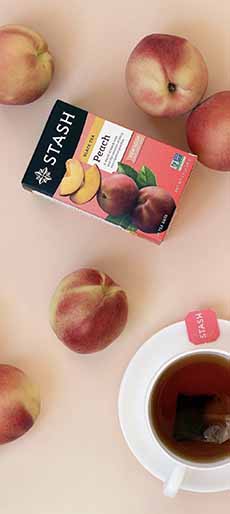Stash Tea Varieties, Specialty Tea For National Tea Month
|
We were quite young when we first learned about Stash Tea. It was in the early 1970s, and in those days, in the Northeast, there were few natural food stores. Yogurt was still a cult food eaten by “health nuts” and people in Greek and Middle Eastern communities. In these days of the hippie, we thought that the name paid homage to one’s stash of illicit substances. The tea, which we ordered from a catalog back then, was great, and we just learned that we were wrong about the name. Things were more progressive in Portland, Oregon, when The Stash Tea Company was founded in 1972. It started in the basement of a suburban Victorian house. There, surrounded by loose teas, herbs and spices, a trio of friends set out to provide better tea than the large brands offered. They started with quality loose tea, and named the company for the special reserve of precious teas that many sea captains kept “stashed” onboard for their personal use. The fledgling company quickly became a player in fine teas. One partner had a mail-order marketing background with Sears, one had worked with Frito-Lay, and the third had management experience at a natural foods store. Offering a better tea alternative to the category monster Lipton and its competitors, Stash made a profit in its first year, mostly by selling to natural foods stores. The customers there appreciated a brand that tasted better than the bagged tea brands then available. By 1975, the company began marketing tea bags and a complete line of traditional, specialty blend, and herbal teas to restaurants and through mail-order catalogs. Restaurants and other segments of the foodservice industry became the company’s bread and butter. Stash Tea launched a website in 1995 with the advent of e-commerce, making their teas available to customers nationwide. After 21 years, the founders sold the company to Yamamotoyama Co., Ltd., a 300-year-old tea company based in Tokyo. They then founded another startup, Tazo Tea, which they eventually sold to Starbucks for $9.1 million. Today, Stash Tea ranks among the top five specialty tea companies in the U.S. It sells a complete line of specialty teas: some 200 teas, tea accessories, and tea gifts. The line is certified kosher by KOF-K. We spent some time on the Stash Tea website—a wealth of options and opportunities for discovery. We first discovered their Double Bergamot Earl Grey black tea bags, which are so much more intensely bergamot than the brands we’d been using. Ditto with the Super Irish Breakfast Tea and the Moroccan Mint Green Tea. We also discovered a delightful selection of tea infusers for loose tea, including the cat in photo #4, plus a dog, a duck, a llama, a hedgehog, a narwhal, a sloth, and a unicorn. Check them out! So treat yourself. Make a cup of tea and relax on StashTea.com for your break. |
|
|
|
________________ *Lipton remains the leading brand of bagged and loose leaf tea in the U.S., with sales of $218 million. Bigelow tea ranks second with $189 million. Twinings of London is third with $93 million, followed by Celestial Seasonings with $88 million. Private-label brands account for about $100 million [source]. Tea is the second most widely consumed beverage worldwide, second to water. In 2018, global tea production amounted to about 5.8 million metric tons. China, India, Kenya, Sri Lanka, and Indonesia were among the main tea producers in 2019, based on volume. China was responsible for the majority of total tea production with 2.8 million metric tons. Pakistan was the leading tea importer, with about $590 million worth [source].
|
||






